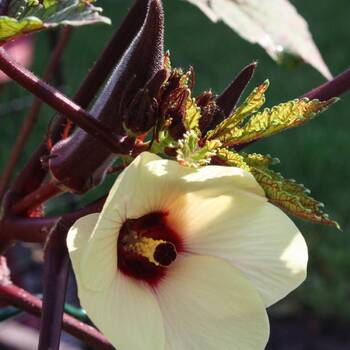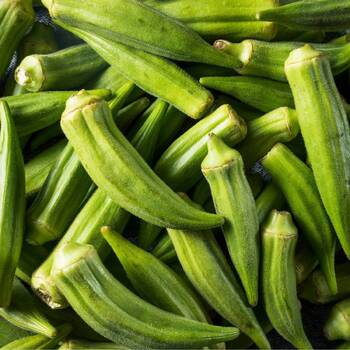
How to Grow Okra Seeds
Grow Guide #2294
Family: Malvaceae
Binomial name: Abelmoschus esculentus
Life Cycle: Perennial (grown as an annual in cool climates)
This 'How to Grow' guide details everything a home gardener needs to know to plant, grow and care for Okra (Abelmoschus esculentus).
When to Sow Okra Seeds
Okra is a warm season crop. Use the table below to identify the best time of year to sow okra seeds in your climate.
| JAN | FEB | MAR | APR | MAY | JUN | JUL | AUG | SEP | OCT | NOV | DEC | |
|---|---|---|---|---|---|---|---|---|---|---|---|---|
| Cool | ||||||||||||
| Temperate | ||||||||||||
| Sub-Tropical | ||||||||||||
| Tropical | ||||||||||||
| Arid |
Preparation
Okra plants are best grown in full sun. Choose a location that will receive at least 6 hours of full sun each day.
Okra plants need a well drained soil enriched with plenty of organic matter. Prepare soil by weeding it thoroughly, digging it over to loosen it and adding aged animal manure or compost. Keep the area free of weeds until planting. Learn more about preparing soil for planting here.
How to Sow Okra Seeds
Okra seeds do not require any treatment (eg soaking, stratification) before sowing.
Okra seeds can be sown directly into the garden OR seedlings can be raised in trays or other containers and transplanted to the garden once established.
Sow Direct
- Sow seeds directly in the garden 10mm deep and 60cm apart, with rows 100cm apart.
- Keep soil moist but never wet or dry.
- Seeds should germinate in around 12-14 days at a soil temperature of 23-33°C.
- Young seedlings will need protection from pests, pets and weather until they are established.
Raise Seedlings
- Fill trays, punnets or jiffy pots with a good quality seed-raising mix, or use soil starter pellets.
- Sow seeds 10mm deep.
- Keep soil moist but never wet or dry.
- Seeds should germinate in around 12-14 days at a soil temperature of 23-33°C.
- Transplant seedlings to the garden once they have their first true leaves and are large enough to handle (usually 5-10cm tall).
- Plant out, spacing plants 60cm apart, with rows 100cm apart.
Okra is a tender crop that’s sensitive to frost. Do not transplant seedlings or sow seeds outside until all danger of frost has passed.
How to Grow Okra
Okra plants may need watering during the growing season. Water when the soil is dry about 5cm below the surface (test this by scratching away a little soil with your finger). Water deeply in the early morning or late afternoon. Avoid watering the leaves of plants to avoid fungal diseases. Learn more about watering here.
If soil was well prepared no extra fertiliser should be necessary. In poor soil or to give your plants an extra boost, application of a balanced fertiliser or one formulated for fruit and vegetables can be beneficial:
- Apply slow release fertiliser at the recommended rate when transplanting or when seedlings are 5-10cm tall.
- Apply liquid fertiliser at the recommended rate and frequency while plants are fruiting or flowering.
How to Harvest Okra
Okra should be ready to harvest in approximately 55-65 days.
Okra pods are ready to harvest when they are 8-10cm long. If pods are left to grow larger they will become tough and stringy. Harvest pods by cutting with snips/secateurs. Harvest regularly to encourage more pods. Okra pods are best eaten soon after they are harvested. They can be stored for a few days in a perforated plastic bag in the fridge.
Common Problems when Growing Okra
Like all plants, okra is susceptible to some pests, diseases and other problems. Below is a list of the most common problems gardeners encounter when growing okra plants:
 Aphids are small (2-4mm long) sap-sucking insects that congregate on the new shoots or the undersides of leaves. They can cause leaves to wilt or become discoloured, and also excrete honeydew which can attract ants and other insect pests. To manage aphids, remove them by spraying with a garden hose, apply a soap or alcohol spray, or encourage predatory insects to your garden. Read more about aphids here.
Aphids are small (2-4mm long) sap-sucking insects that congregate on the new shoots or the undersides of leaves. They can cause leaves to wilt or become discoloured, and also excrete honeydew which can attract ants and other insect pests. To manage aphids, remove them by spraying with a garden hose, apply a soap or alcohol spray, or encourage predatory insects to your garden. Read more about aphids here.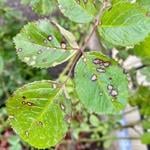 Bacterial leaf spot is a disease that causes irregularly shaped brown spots on all above-ground parts of a plant. The spots at first appear to be wet but become dry and scab-like over time. Leaves and flowers can fall prematurely. Water plants at soil level (not on the leaves), dispose of fallen leaves and fruit and practice crop rotation.
Bacterial leaf spot is a disease that causes irregularly shaped brown spots on all above-ground parts of a plant. The spots at first appear to be wet but become dry and scab-like over time. Leaves and flowers can fall prematurely. Water plants at soil level (not on the leaves), dispose of fallen leaves and fruit and practice crop rotation.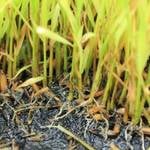 Damping off is caused by a fungal growth that transfers from the soil to seeds or tender seedlings. Seeds may appear not to germinate, or young plants start to rot when they emerge from the soil and become soft and mushy at the base before dying. Use new potting mix if raising seedlings, do not water foliage and avoid waterlogged soil. Read more about damping off here.
Damping off is caused by a fungal growth that transfers from the soil to seeds or tender seedlings. Seeds may appear not to germinate, or young plants start to rot when they emerge from the soil and become soft and mushy at the base before dying. Use new potting mix if raising seedlings, do not water foliage and avoid waterlogged soil. Read more about damping off here.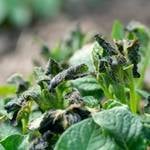 Frost damage can cause leaves to wilt and go black. Do not plant seedlings in the garden until all danger of frost has passed in spring, and harvest plants before winter. Prune all frost-damaged leaves to avoid them rotting on the plant.
Frost damage can cause leaves to wilt and go black. Do not plant seedlings in the garden until all danger of frost has passed in spring, and harvest plants before winter. Prune all frost-damaged leaves to avoid them rotting on the plant.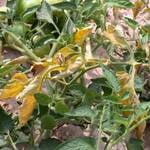 Fusarium wilt and verticillium wilt are diseases caused by soil-borne fungi. The fungi enter a plants’ roots and prevent water and nutrients from moving through plants. Leaves and branches will wilt, dry off and die and leaves may yellow. There is no cure for wilt but choosing resistant varieties, disposing of affected plants and soil, practicing good garden hygiene and crop rotation will all help to prevent it spreading.
Fusarium wilt and verticillium wilt are diseases caused by soil-borne fungi. The fungi enter a plants’ roots and prevent water and nutrients from moving through plants. Leaves and branches will wilt, dry off and die and leaves may yellow. There is no cure for wilt but choosing resistant varieties, disposing of affected plants and soil, practicing good garden hygiene and crop rotation will all help to prevent it spreading..jpg) Powdery mildew is caused by fungal spores reproducing on the leaves of plants. First showing as white spots on leaves, affected areas can spread quickly to cover the entire leaf surface. While rarely fatal, powdery mildew can reduce yields. Water plants at soil level (not on leaves) to prevent spreading spores, allow good air flow between plants, remove affected leaves and if necessary spray with an appropriate fungicide or homemade spray. Read more here about powdery mildew here.
Powdery mildew is caused by fungal spores reproducing on the leaves of plants. First showing as white spots on leaves, affected areas can spread quickly to cover the entire leaf surface. While rarely fatal, powdery mildew can reduce yields. Water plants at soil level (not on leaves) to prevent spreading spores, allow good air flow between plants, remove affected leaves and if necessary spray with an appropriate fungicide or homemade spray. Read more here about powdery mildew here.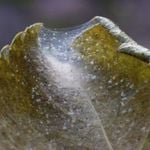 Spider mites (Tetranychus urticae), also known as two spotted mites, are sap-sucking arachnids that cause dry, wilted or discoloured leaves. The undersides of leaves may feel dry and a little like fine sandpaper. Prune plants to allow good air flow or spray with eco-oil or wettable sulphur. Learn more about managing spider mites here.
Spider mites (Tetranychus urticae), also known as two spotted mites, are sap-sucking arachnids that cause dry, wilted or discoloured leaves. The undersides of leaves may feel dry and a little like fine sandpaper. Prune plants to allow good air flow or spray with eco-oil or wettable sulphur. Learn more about managing spider mites here.


.png)



